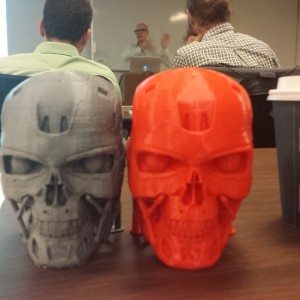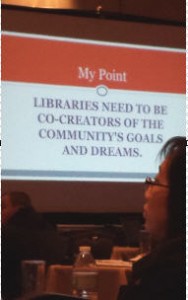The NERCOMP group that did the 3D printing workshop was exceptional. (Norwood, Massachusetts. Workshop held on 6/10/15.)
- Bryan Alexander, President, Bryan Alexander Consulting
- Ian Roy, Research Technology Project Lead, Brandeis University
- John Eberhart, Director of Digital Media, Yale School of Architecture
In addition to the speakers, there were a few very knowledgeable attendees.
Here are some of the highlights from the workshop. The information below doesn’t go into specific workflows, and is incomplete in terms of the steps I didn’t include, as this is just an overview.
Types of Printers:
Those who have a lot of experience with 3D printers said:
- Makerbot is showing signs of slowing their innovation, and although their newer printers are much better than the earlier generations, they are not recommended for those getting into the 3D printing arena. (In a recent tweet from Nercomp, Bryan Alexander reported “A lot of skepticism about Makerbot’s future…”.)
- Recommended printers: Lulzbot Taz, Printrbot, Makergear, Ultimaker2.
Things to note about the printers:
- They can be noisy.
- They can smell odd when printing.
- Some use different types of materials to print with (Plastics and/or powder, and more. ABS, PLA, Nylon were all mentioned.), other printers are more limited.
- They have products to recycle plastic to be used in 3D printing. These are called filabot reclaimers.
- Other costs might include the Smart Extruder if you have a Makerbot, and print heads.
Working with Printers: Software
- 90% of person time will be spent creating the model to be printed.
- The file type that needs to be added to the printer is a .stl.
- Some .stl files are available at http://www.thingiverse.com/, but as a “representational tool” or “design tool” (Terms used by John Eberhart from Yale), you need to use a program like CAD, Maya, or Sketchup.
- Some use Sketchup, but that has some limitations, and many think to use it because it was free, but they now have started to charge for its use.
- Among many other things, Brandeis is using 123D Catch (App for droid and iPhone to create a 3d image using a cell phone.) along with TinkerCad. (A web based program that allows for adjustments to be made to uploaded .stl files.)
- Printing can be additive, and subtractive. (Additive is creating by adding material bit by bit. Subtractive is taking a solid, and taking away material to reveal the object. )
Marketing and Outreach:
- Faculty need to be approached in a variety of ways
- Some departments that have been early adopters included archaeology, classical studies, history, theater (building sets for plays), engineering, art, math, robotics, media studies, business, psychology, engineering, etc.
- Some opportunities exist in outreach with the community. Maybe looking for volunteers from those who have retired, but want to look at using their skills with this new techology.
Speakers
Brandeis: Ian Roy
- Staffing at Brandeis includes 1 FTE, and 4+ students.
- Much funding was obtained from the student organizations, and sponsors.
- The students have a very active club.
- 3D printing is part of the larger MakerLab at Brandeis.
- The Maker Lab has their own room.
- They require that people get certified on the machine before they can work on a project.
- They don’t charge for the use of the printers, and consider a project with a good educational justification as the currency.
- Ian Roy at Brandeis said 3D printing is as disruptive as the internet. It will change the way we do things.
Yale: John Eberhart
- Yale has a long history with 3D printing in their Architecture department. Going back to 1999.
- Yale charges for print jobs.
- Newer printers dropped prices dramatically. An item that would have cost students over $200 was reproduced at a cost of $24 with the new printers
- As the cost of printing went down, the numbers of print jobs, and printers went up. 2012-13 they had 2 printers and did 50 jobs. 2013-14 they had 18 printers and did 2,500 jobs. 2014-15 they had 31 printers and did 5,100 jobs.
- The print jobs are happening in a printer farm, which pretty much runs non-stop. The printers are locked up, but visible through glass, and students will often look to see what others are doing. This may encourage further exploration, and generate new ideas.
- The newer 3D printers became very popular at Yale because the rendering was quicker and less expensive than other printers, and the quality was good enough for the job at hand.
Some apps and suggested pages
I should taken pictures of the prosthetic arms and leg they had created, but I just got a picture of these skulls. In the background is Ian Roy from Brandeis, sporting the frames he printed off of the 3D printer.


